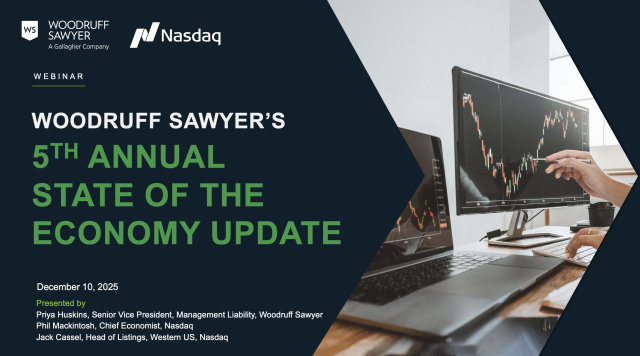Blog
The Compensation Clawback Rules: The Rules That Haven’t Changed Much of Anything
Section 954 of the Dodd-Frank Wall Street Reform and Consumer Protection Act of 2010 required the Securities and Exchange Commission (SEC) to issue rules mandating the recovery of incentive-based compensation in the case of a financial restatement (“clawbacks”).
The SEC issued proposed clawback rules in 2015. These rules were met with broad criticism. They then basically sat untouched until late 2021, when the SEC reopened them for discussion.
It wasn’t until the end of 2022 that the SEC finally made them official. The clawback rule went into effect in December 2023. That’s 13 years later.
And now, a little over a year later, the data is in, and what it found was this: A big nothingburger.
We have yet to see a notable uptick in the frequency of compensation clawbacks.

Dodd-Frank Clawback Rule
The concept of a clawback is not new. Recall that Section 304 of the Sarbanes-Oxley Act implemented a clawback of incentive-based and equity-based compensation awarded to CEOs and CFOs if misconduct led to an accounting restatement.
The Dodd-Frank clawback rule, Rule 10D-1, is much more expansive. Issued pursuant to Section 954 of Dodd-Frank, it applies to all executives regardless of whether or not the restatement was the result of misconduct. Further, companies are required to implement a three-year look-back window for incentive-based compensation.
Read our blog for more details on the Dodd-Frank clawback.
Critically, the Dodd-Frank clawback only requires the recovery of the part of the incentive compensation that was awarded in excess of what the executive would have earned under the restatement.
It turns out, this can be a challenging calculation. Consider, for example, common metrics like total shareholder return (TSR). Calculating at what percentile a company’s TSR “would have been” is no easy feat. Also, consider this broader point: if the incentive compensation metrics are not impacted by the financial restatement, one could reasonably conclude that there was no erroneously awarded compensation.
Recovery Analyses Are Happening, but Clawbacks Are Not
A “recovery analysis” is generally conducted any time a restatement occurs.
Under the SEC’s final rule, both “Big R” (material) and “little r” (immaterial) restatements can trigger the need for a recovery analysis. That makes the bar for triggering a review quite low.
Based on analysis by Deep Quarry, through the first six months of 2025, there have been 50 companies that have included recovery analysis disclosures in their filings. Through the same period, only six companies disclosed the clawback of executive compensation following an accounting restatement. While it’s more than the two companies that disclosed clawbacks in the first half of 2024, the delta thus far is underwhelming.
Perhaps a Solution Looking for a Problem?
Yes, this is early data. But at this point, the clawback rules feel like a solution looking for a problem.
It’s true that we don’t know to what extent companies have modified their compensation plans to avoid having to make payouts given the implementation of the new rules. However, it seems unlikely that there have been massive changes because shareholders (or at least governance folks who analyze these sorts of things) would have noticed.
If clawbacks were to surface more prominently in the future, we may see companies modify their compensation programs to create more predictability for their executives.
Having said that, it seems unlikely that most efficient and motivating compensation programs would be shaped by fear of regulatory clawbacks.
The Case for Insurance Hasn’t Materialized
When the SEC finalized its clawback rule, it noted that executives might consider purchasing third-party insurance to manage their personal financial risk.
However, the rule prohibits an issuer from paying or reimbursing the executive officer for premiums for such an insurance policy.
The SEC was right that people would be interested in this type of coverage, but we have not seen a robust market response.
Some carriers stepped forward with coverage options designed to respond to clawback demands. However, the limits were low, the premiums were high, and the coverage had to be paid for by individuals, not the company.
If the rule starts to have real consequences, the insurance market may eventually respond. But if that happens, one wonders: If executives can simply insure against the risk, what accountability does the rule actually enforce?
Further, consider this: the greater risk executives face of losing their incentive compensation, the greater the amount of incentive compensation a company needs to award to attract and retain talent (e.g., an uncertain dollar is worth less than a certain dollar).
This means that companies will have to offer even larger incentive bonuses—or at least add to the bonus an amount that would directionally cover the insurance costs that executives now have to pay out of their own pockets.
Stay Vigilant, but Keep Perspective
While the SEC’s new clawback rule hasn’t resulted in much change, it’s still early.
Companies remain legally obligated to evaluate restatements and should continue documenting their recovery analyses carefully.
That said, one year in, the rule’s practical impact has been minimal. The insurance market hasn’t offered a meaningful solution, and the risk remains largely theoretical for now.
Disclaimer: The views expressed in this publication are solely those of the author; they do not necessarily reflect the views of AJG. Further, the information contained herein is offered as general industry guidance regarding current market risks, available coverages, and provisions of current federal and state laws and regulations. It is intended for informational and discussion purposes only. This publication is not intended to offer financial, tax, legal or client-specific insurance or risk management advice. No attorney-client or broker-client relationship is or may be created by your receipt or use of this material or the information contained herein. We are not obligated to provide updates on the information contained herein, and we shall have no liability to you arising out of this publication. Woodruff Sawyer, a Gallagher Company, CA Lic. #0329598
Authors
Table of Contents












